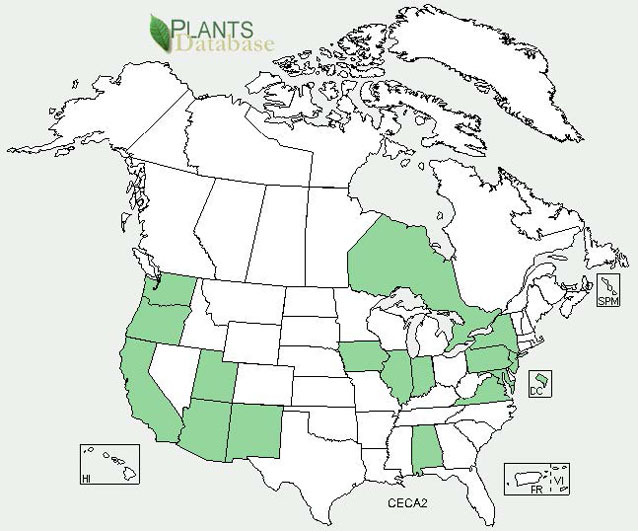Asteraceae (Sunflower family)
At a Glance

© Steve Dewey / Utah State University
- Annual, biennial, or short-lived perennial
- Highly branched stems that grow up to three feet tall.
- Stems and leaves have fine, cobwebby hairs when young.
- Basal rosette has a central cluster of spines.
- Stem leaves are five to eight inches long and have dots of resin on the surfaces.
- Purple flowers are subtended by green to straw-colored, spine-tipped bracts.
- Flowers June through November.
- Fruit is a white achene with brown streaks.
Habitat and Ecology
Purple starthistle (Centaurea calcitrapa) is found along the West Coast, in the Southwest, and in scattered eastern states. Native to southern Europe and northern Africa, it was introduced into California in the early 1900s. Purple starthistle is highly competitive, and because it is unpalatable, it increases on rangelands as more palatable species are consumed. Purple starthistle can colonize most soil types with a disturbed top layer, but it seldom persists in shaded areas. It is found in fields, roadsides, disturbed open sites, grasslands, overgrazed rangelands, and logged areas, from sea level to 5,500 feet in elevation.

USDA
Description

© Malcolm Storey
Purple starthistle is a bushy thistle with highly branched stems and a stout taproot. It can act as an annual, a biennial, or a short-lived perennial. It first grows a basal rosette and later produces stems in late spring and summer. The stems grow up to three feet tall. Purple starthistle reproduces by seeds that can remain in the soil for three years. The seedhead falls as a unit near the parent plant, but the seeds can then disperse via vehicles, heavy machinery, water, and soil movement, and by clinging to shoes, clothes, tires, and fur and feathers of animals. Infestations can result in dense, impenetrable stands.
Leaves
Before growing flowering stems, purple starthistle exists as a basal rosette with a central cluster of spines. On the stems, the leaves are alternate, with deeply divided lower leaves and narrow and undivided upper leaves. The upper stem leaves are not winged. The leaves are five to eight inches long and have dots of resin on their surfaces. Young leaves and stems have fine, cobweb-like hairs that fall off in time.

CDFA Seed Laboratory
Flowers and Fruits
Purple starthistle flowers are purple and 0.6 to 1 inches in diameter. Twenty-five to 40 florets make up each flower head. Underneath the flower are spine-tipped bracts that are greenish or straw-colored. Purple starthistle flowers June through November.
The fruit is an achene (a dry fruit with a single seed and thin walls that does not open at maturity; for example, a sunflower “seed”). Purple starthistle achenes are oblong and 2.5-3.5 mm long. They are white and often streaked with brown. Usually, no bristles cap the achene.
Etymology
Centaur’ea/Centaur’ium is a reference to the Centaur Chiron who supposedly discovered the medicinal uses of a plant in Greece that came to be called Centaury. Calcitra’pa comes from the word caltrop, which was a four-pointed weapon usually positioned on the ground to impede enemy movements.
Similar Species
Purple starthistle can be confused with other invasive Centaurea species, like spotted knapweed (Centaurea maculosa), diffuse knapweed (Centaurea diffusa), squarrose knapweed (Centaurea squarrosa), and Iberian starthistle (Centaurea iberica). See https://www.cdfa.ca.gov/plant/ipc/encycloweedia/weedinfo/centaurea.htm for comparisons among these species.
Control Methods
Possible control methods are explained at these websites:
References
California Department of Food and Agriculture. No date. Centaurea in Enycyloweedia. Available at https://www.cdfa.ca.gov/plant/ipc/encycloweedia/weedinfo/centaurea.htm.
Charters, M. L. 2009. California plant names: Latin and Greek meanings and derivations. Available at http://www.calflora.net/botanicalnames (accessed 9 March 2010).
Keil, D. J., and J. Ochsmann. 1997. Centaurea. In: Flora of North America Editorial Committee, editors. 1993+. Flora of North America North of Mexico. 15+ vols. New York and Oxford. Vol. 19, 20, and 21, pp. 191.
Nevada Cooperative Extension. Wanted—dead, not alive! Purple starthistle. University of Nevada, Reno, NV.
San Francisco Peaks Weed Management Area. No date. Purple starthistle, Centaurea calcitrapa. Flagstaff, AZ.
Prepared by Kelly Reeves, Southern Colorado Plateau Network Inventory and Monitoring Program, 2010.
Last updated: April 29, 2016
